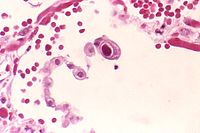
Photo from wikipedia
β‐ and γ‐herpesviruses persistently infect most of the world population, largely without clinical manifestations. However, in immunosuppressive settings like transplantation, these viruses are often jointly reactivated, associating with graft dysfunction/rejection,… Click to show full abstract
β‐ and γ‐herpesviruses persistently infect most of the world population, largely without clinical manifestations. However, in immunosuppressive settings like transplantation, these viruses are often jointly reactivated, associating with graft dysfunction/rejection, HCMV disease, and lymphoproliferation. In HIV/AIDS, direct interaction mechanisms have been described for EBV and KSHV in primary effusion lymphoma, demonstrating that the cooperation between both viruses enhances lymphomagenesis. Here, we discuss the clinical evidence supporting that the simultaneous reactivation of these viruses increases the probability of mutual interactions, also providing a conceptual framework explaining how one virus can influence another. Specifically, we propose mechanisms of indirect communication through immune soluble mediators, mainly cytokines, chemokines, and IFN regulatory molecules, based on common features of their infectious cycles and the convergent need on immunomodulatory mechanisms. This latter point should be experimentally addressed in feature research.
Journal Title: Journal of Leukocyte Biology
Year Published: 2022
Link to full text (if available)
Share on Social Media: Sign Up to like & get
recommendations!